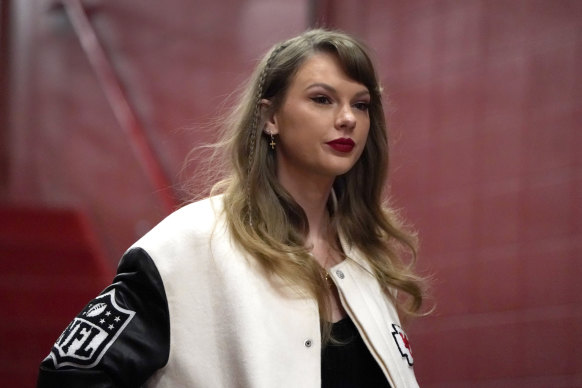This was published 9 months ago
X enforces Taylor Swift search ban after deepfake pornography floods social media
By Nell Geraets
X, formerly known as Twitter, has blocked all searches for “Taylor Swift” after sexually explicit AI-generated images of the pop star inundated social media last week.
When searching for the singer’s name on the site, an error message reads: “Something went wrong. Try reloading”. However, it only applies when searching for the singer’s first and last name consecutively.

X has blocked all search results for “Taylor Swift” after graphic images of the singer went viral last week.Credit: AP
The decision to block such content is a temporary action, said X’s head of business operations, Joe Benarroch, and is being handled with “an abundance of caution” to prioritise safety.
Last week, sexually explicit and abusive fake images of Swift began circulating online, triggering fans to flood the social media platform with more positive images of the singer alongside the #ProtectTaylorSwift hashtag.
According to an NBC report, the fake images generated more than 27 million views in 19 hours before the account that originally posted the sexually explicit content was suspended. In response, X released a statement on Friday, reiterating its stance on non-consensual nudity images.
“We have a zero-tolerance policy towards such content,” the statement, which was posted on X, read. “Our teams are actively removing all identified images and taking appropriate actions against the accounts responsible for posting them. We’re closely monitoring the situation to ensure that any further violations are immediately addressed, and the content is removed. We’re committed to maintaining a safe and respectful environment for all users.”
Elsewhere, Meta (which owns Facebook) has also worked to remove the explicit content, releasing a statement that strongly condemns the images that have appeared across different internet services.
“We continue to monitor our platforms for this violating content and will take appropriate action as needed,” the company said.
Since the graphic images went viral, various organisations have called for action against the proliferation of damaging deepfake content. The White House Press Secretary Karine Jean-Pierre urged Congress to take legislative action on the issue, noting that lax enforcement disproportionately impacts women and girls.
On Friday, the Hollywood actors’ union SAG-AFTRA also condemned the images, describing them as “upsetting, harmful and deeply concerning”.
“The development and dissemination of fake images – especially those of a lewd nature – without someone’s consent must be made illegal,” the union said. “As a society, we have it in our power to control these technologies, but we must act now before it is too late.”
The union also voiced its support for New York Democrat Joe Morelle, who is pushing a bill that would criminalise the sharing of deepfake porn online.
Deepfakes use artificial intelligence, known as “deep learning”, to create fake images or videos of real people. This usually involves manipulation of their body or face. According to the BBC, there has been a 550 per cent rise in the creation of such manipulated imagery since 2019.
Researchers suspect the fake Swift images were created by diffusion models – a generative artificial intelligence model that can produce new and photorealistic images from written prompts. This includes models like Midjourney, Stable Diffusion and OpenAI’s DALL-E.
Microsoft currently offers an image generator based partly on DALL-E. Its chief executive, Satya Nadella, called the fake Swift images “alarming and terrible” in an interview with NBC News, adding that “irrespective of what your standing on any particular issue is, I think we all benefit when the online world is a safe world.”
Microsoft is currently in the process of investigating whether its image-generator tool was misused.
In Australia, civil and criminal legislation do not penalise the creation and possession of pornographic deepfakes, meaning it remains difficult to prosecute its distribution. Intellectual property and media lawyers Ted Talas and Maggie Kearney said in a report that the legal frameworks currently in place to regulate deepfakes are probably insufficient to address the challenge they pose to individuals.
“Future legislative reform will only ever form part of an effective solution. What is required is the continuing development of effective tools to detect, identify and alert internet users of deepfakes.”
Find out the next TV, streaming series and movies to add to your must-sees. Get The Watchlist delivered every Thursday.